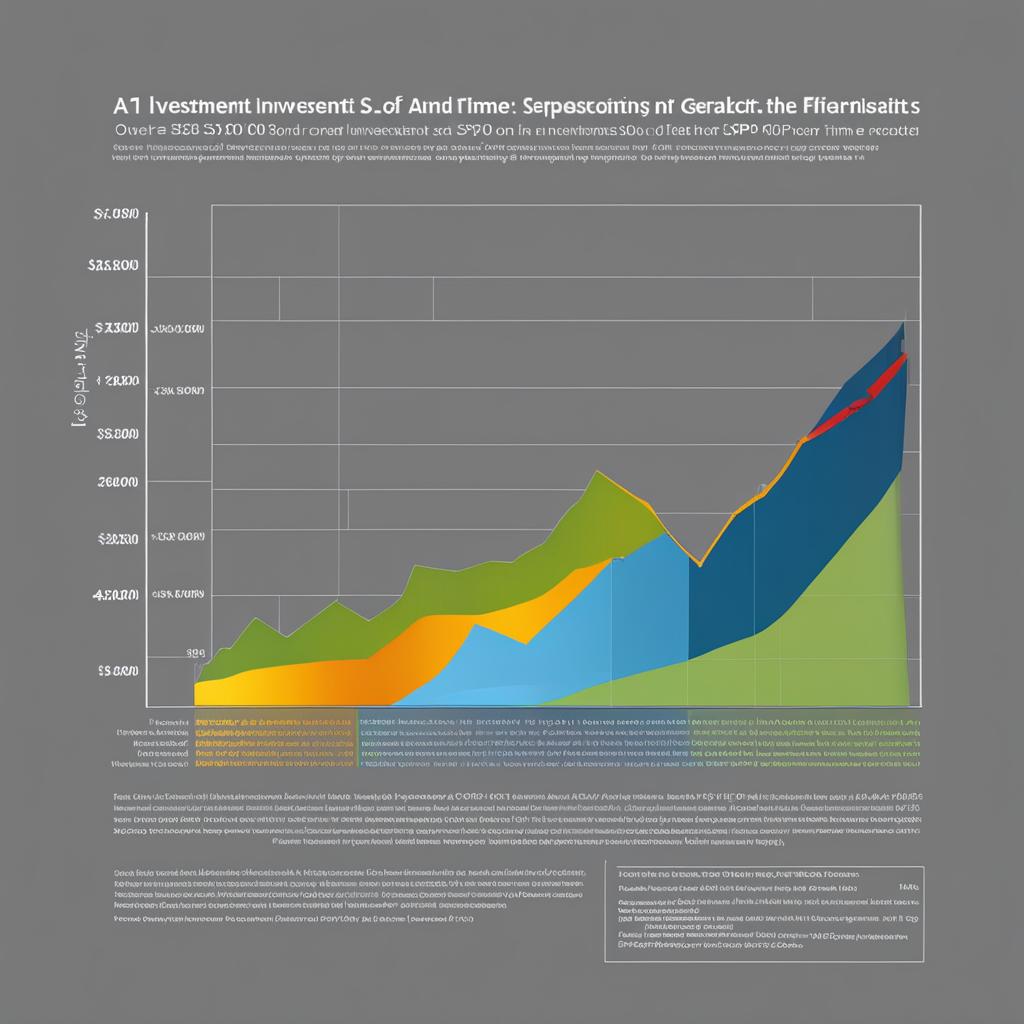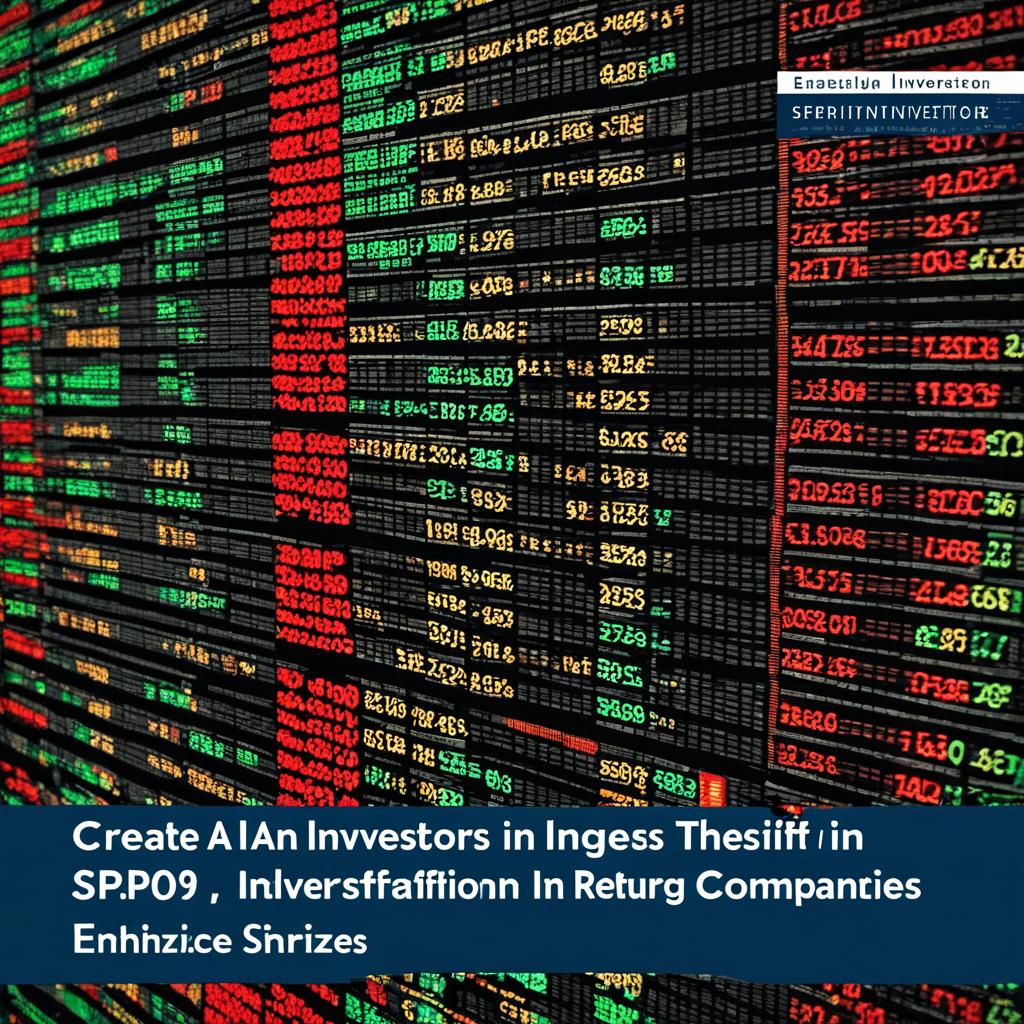Hello, I’m here to guide you on how to invest in the S&P 500, one of the most popular stock market indexes that represents a diverse range of large U.S. companies. Investing in the S&P 500 can be a great way to participate in the growth of the U.S. stock market and potentially achieve long-term returns. Let’s explore the various investment options and strategies available for the S&P 500.
When it comes to investing in the S&P 500, there are two main options: investing in individual stocks or investing in S&P 500 index funds or exchange-traded funds (ETFs). Both options have their pros and cons, so it’s essential to understand them before making any investment decisions.
Key Takeaways:
- Investing in the S&P 500 offers exposure to a diverse range of large U.S. companies.
- Two main options for investing in the S&P 500: individual stocks or index funds/ETFs.
- Individual stock investing provides more control but carries higher risk.
- Index funds and ETFs offer diversification and a more passive approach.
- Consider your investment goals, risk tolerance, and time horizon when choosing the right approach.
Investing in Individual Stocks
When it comes to investing in the S&P 500, one option to consider is investing in the individual stocks that make up the index. This approach involves purchasing shares of each company separately, giving you direct ownership of those specific stocks.
By investing in individual stocks, you have more control over your investment portfolio and the potential for higher returns. You can choose which companies to invest in based on your research and analysis of their performance and prospects. This allows you to tailor your investments to align with your investment strategy and goals.
However, it’s important to note that investing in individual stocks requires a significant amount of time, effort, and expertise. You need to stay updated with the latest news and developments in the companies you invest in, as well as the broader market conditions. This active management approach may not be suitable for all investors.
“Investing in individual stocks allows for more control and potential for higher returns, but it also requires more time, effort, and expertise.”
It’s important to conduct thorough research and analysis before investing in individual stocks. Consider factors like the company’s financial health, industry trends, competitive advantages, and management team. Diversifying your portfolio by investing in stocks from different sectors can help mitigate risks associated with individual company performances.
Benefits of Investing in Individual Stocks
Investing in individual stocks offers several potential benefits:
- Control: With individual stock investments, you have the ability to construct a portfolio that aligns with your specific investment goals and preferences.
- Opportunity for higher returns: Selecting the right stocks and making informed investment decisions can lead to substantial returns, especially if you are able to identify undervalued stocks or companies with strong growth potential.
- Flexibility: Investing in individual stocks provides the flexibility to adjust your portfolio based on changing market conditions or your own investment strategy.
Risks of Investing in Individual Stocks
It’s important to be aware of the risks associated with investing in individual stocks:
- Risk of individual company performance: Investing in individual stocks exposes you to the risk that a particular company may underperform or face financial difficulties, which could impact the value of your investment.
- Higher volatility: Individual stocks can be more volatile compared to investing in a diversified portfolio or index funds. Market fluctuations or company-specific news can result in significant price swings.
- Time and effort: Investing in individual stocks requires ongoing research, monitoring, and decision-making. It may not be suitable for investors who prefer a more passive or hands-off approach to investing.
Before investing in individual stocks, carefully consider your risk tolerance, time commitment, and investment objectives. It may be helpful to consult with a financial advisor or investment professional to ensure your investment strategy aligns with your goals and risk profile.
The image above depicts the potential of individual stock investing in the SP 500.
Investing in S&P 500 Index Funds and ETFs
When it comes to investing in the S&P 500, one of the popular options is to invest in S&P 500 index funds or exchange-traded funds (ETFs). These investment vehicles are specifically designed to track the performance of the S&P 500 index, providing investors with exposure to a diversified range of large U.S. companies.
By investing in S&P 500 index funds or ETFs, you can benefit from the advantages of broad market exposure and diversification. Rather than trying to select individual stocks and potentially missing out on certain company’s performances, these funds offer a simpler way to invest in the overall performance of the S&P 500.
The key advantage of investing in S&P 500 index funds or ETFs is their passive nature. These funds are managed to replicate the performance of the index, rather than aiming to outperform it. This makes them an attractive option for investors seeking a more hands-off approach to investing in the S&P 500, as they eliminate the need for extensive research and analysis.
The benefits of investing in S&P 500 index funds and ETFs:
- Diversification: By investing in S&P 500 index funds or ETFs, you gain exposure to a wide range of companies across various sectors. This diversification helps spread out the investment risk and can potentially mitigate the impact of market fluctuations.
- Lower Costs: S&P 500 index funds and ETFs typically have lower management fees and expense ratios compared to actively managed funds. This can contribute to higher net returns over the long term.
- Liquidity and Flexibility: ETFs, in particular, offer the advantage of being traded throughout the day, allowing investors to buy or sell shares at market prices whenever the stock market is open. They also provide the flexibility to buy fractional shares, making it easier to invest smaller amounts.
- Transparency: S&P 500 index funds and ETFs disclose their holdings regularly, providing investors with transparency regarding the companies they are invested in.
Investing in S&P 500 index funds or ETFs can be an efficient and convenient way to participate in the performance of the S&P 500. However, it’s important to carefully consider your investment objectives, risk tolerance, and time horizon before making any investment decisions.

How to Invest in the S&P 500 in Two Steps
Investing in the S&P 500 can be a great way to participate in the growth of the U.S. stock market. If you’re interested in investing in this popular index, here’s a straightforward two-step process to get started:
- Open an investment account: The first step is to open an investment account, such as a brokerage account. This account will serve as your gateway to the stock market and allow you to buy and hold investments, including S&P 500 stocks and index funds.
- Choose your investments: Once you have an investment account, you can start choosing your investments in the S&P 500. You have two main options: investing in individual stocks or investing in index funds or ETFs that track the S&P 500.
Investing in individual stocks requires some research and analysis to identify promising companies within the index. This approach allows for greater control over your investments and the potential for higher returns, but it also carries more risk and requires active management.
On the other hand, investing in S&P 500 index funds or ETFs offers a more passive approach. These funds are designed to replicate the performance of the S&P 500, providing instant diversification across the 500 companies in the index. This strategy is popular among investors who prefer a hands-off approach and want to minimize risk.
Once you’ve decided on your investment approach, simply follow the instructions within your brokerage account to make the desired investments. It’s important to regularly monitor your investments and make any necessary adjustments to ensure your investment strategy remains aligned with your financial goals.
By following these two simple steps, you can start investing in the S&P 500 and take advantage of the potential investment opportunities it offers.

Costs of Investing in the S&P 500
When considering investing in the S&P 500, it is essential to understand the costs associated with different investment options. The costs can vary depending on whether you choose to invest in S&P 500 index funds or ETFs, or individual stocks.
Investing in S&P 500 Index Funds or ETFs
When investing in S&P 500 index funds or ETFs, there may be expenses such as management fees and expense ratios. These costs are typically low compared to other investment options and are considered a more cost-effective way to gain exposure to the S&P 500. These funds aim to track the performance of the index, allowing you to invest in a diversified portfolio of stocks.
“Investing in S&P 500 index funds or ETFs offers a cost-effective way to gain exposure to the entire index, minimizing the need for extensive research and reducing the overall expenses associated with managing a portfolio of individual stocks.”
Investing in Individual Stocks
Investing in individual stocks requires purchasing shares of each company included in the S&P 500. While it offers more control and potential for higher returns, it also comes with additional costs. When investing in individual stocks, there may be trading fees and charges associated with each transaction. These costs can add up, especially for active traders who make frequent buy and sell transactions.
“Investing in individual stocks can result in higher costs due to trading fees and charges associated with each transaction. It requires thorough research and analysis to identify potential winners, making it a more time-consuming and costly investment strategy.”
Considering the Costs
When deciding on an investment approach for the S&P 500, it’s important to consider the costs associated with each option. While investing in individual stocks may provide more control and potential for higher returns, it also comes with higher costs. On the other hand, investing in S&P 500 index funds or ETFs offers a more cost-effective way to gain exposure to the index, making it a popular choice among investors.
Ultimately, the choice between individual stocks and index funds or ETFs depends on your investment goals, risk tolerance, and overall financial strategy.

Benefits of Investing in the S&P 500
Investing in the S&P 500 provides numerous benefits that can enhance your investment strategy and potentially help grow your wealth over time. Below are three key advantages of investing in the S&P 500:
1. Diversification through Broad Exposure
By investing in the S&P 500, you gain exposure to a broad range of large U.S. companies. The index comprises 500 companies from various sectors, including technology, healthcare, finance, and more. This diversity allows you to spread your investment across different industries and companies, reducing the impact of a single stock or sector on your overall portfolio.

2. Historical Long-Term Returns
Historically, the S&P 500 has delivered consistent long-term returns. Although past performance doesn’t guarantee future results, the index has consistently displayed an upward trend over time. This long-term growth potential can be advantageous for investors with a goal of accumulating wealth or saving for retirement.
3. Passive Investing with Index Funds and ETFs
Investing in the S&P 500 through index funds or exchange-traded funds (ETFs) offers a passive investment approach. Index funds are designed to mirror the performance of the S&P 500 by holding the same stocks in the same proportion as the index. ETFs, on the other hand, trade on stock exchanges and can be bought or sold throughout the trading day. Both options provide an easy way to invest in the S&P 500 without the need for extensive research or ongoing management.
Investing in the S&P 500 can be a valuable strategy with the potential to generate long-term wealth and achieve your financial goals. Whether you prefer a hands-on approach by investing in individual stocks or a more passive approach through index funds or ETFs, the S&P 500 offers investment opportunities designed to help you grow your portfolio.
Drawbacks of Investing in the S&P 500
While investing in the S&P 500 offers numerous benefits, it is important to consider the potential drawbacks before making your investment decisions. Here are a few key points to keep in mind:
- Limited Exposure to Smaller Companies and International Markets: The S&P 500 primarily consists of large-cap U.S. stocks. While these companies are generally stable and well-established, investing solely in the S&P 500 may limit your exposure to smaller companies with significant growth potential or international markets that could diversify your portfolio.
- Composition Changes: The S&P 500’s composition is not static and can change over time. New companies can be added or removed from the index based on various factors such as market performance and industry shifts. These changes can impact the overall performance of the index, making it necessary to closely monitor and adjust your investment strategy accordingly.
- Risk and Research: Investing in individual stocks that are part of the S&P 500 requires thorough research and analysis. As each company’s performance can vary, selecting the right stocks can be challenging and carries a higher level of risk compared to investing in diversified S&P 500 index funds or ETFs.
It is important to understand these drawbacks and carefully evaluate your investment goals, risk tolerance, and time horizon before deciding to invest in the S&P 500.
In the words of Warren Buffett:
“Most investors, both institutional and individual, will find that the best way to own common stocks is through an index fund that charges minimal fees. Those following this path are sure to beat the net results (after fees and expenses) delivered by the great majority of investment professionals.”
| S&P 500 | Individual Stocks | Index Funds/ETFs | |
|---|---|---|---|
| Diversification | Provides exposure to large U.S. companies | Depends on individual stock selection | Diversified portfolio of S&P 500 stocks |
| Risk | Market volatility affects overall performance | Higher risk as individual stocks can be volatile | Lower risk due to diversified holdings |
| Effort & Research | Requires monitoring and adjusting strategy | Extensive research and analysis needed | Passive approach, minimal research required |
| Flexibility | No flexibility in selecting individual stocks | Flexible stock selection based on preferences | Flexible trading throughout the day |
| Expenses | Low expenses compared to other investments | Trading fees and charges associated with each transaction | Management fees and expense ratios |
How S&P 500 Index Funds and ETFs Work
S&P 500 index funds and ETFs are popular investment vehicles that aim to replicate the performance of the S&P 500 index. These funds offer investors a way to gain exposure to the entire index without having to buy individual stocks. Let’s take a closer look at how S&P 500 index funds and ETFs work.
Investing in the Entire Index
When you invest in an S&P 500 index fund or ETF, your money is pooled together with other investors’ funds to buy shares of the companies included in the index. The fund managers ensure that the portfolio composition aligns with the stocks in the S&P 500 index and their respective weights.
By holding a basket of stocks from various companies within the index, these funds offer instant diversification. This diversification can help reduce risk by spreading your investment across different sectors and companies within the U.S. stock market.
S&P 500 index funds and ETFs are passively managed. This means that they aim to match the performance of the S&P 500 index rather than actively selecting stocks to outperform the market. As a result, these funds typically have lower management fees compared to actively managed funds.
Key Features and Advantages
S&P 500 index funds and ETFs offer several key features and advantages for investors:
- Instant Diversification: Investing in S&P 500 index funds or ETFs allows you to diversify your portfolio across a broad range of large U.S. companies.
- Lower Costs: These funds typically have lower expense ratios compared to other investment options, making them suitable for cost-conscious investors.
- Easy Accessibility: S&P 500 index funds and ETFs can be purchased through brokerage accounts or investment platforms, making them easily accessible to individual investors.
- Liquidity: ETFs can be traded throughout the trading day, offering investors flexibility in buying and selling shares.
Performance and Tracking
It’s important to note that while S&P 500 index funds and ETFs aim to replicate the performance of the index, there may be slight variances due to factors such as tracking error and fees. Therefore, it’s always advisable to review the fund’s historical performance and track record before making an investment.
Choosing the Right Fund
When selecting an S&P 500 index fund or ETF, consider factors such as expense ratios, any minimum investment requirements, historical performance, and the fund’s tracking methodology. It’s also important to ensure that the fund aligns with your investment objectives and risk tolerance.
Choosing Between Index Funds and ETFs
When it comes to investing in the S&P 500, you have two main options: index funds and exchange-traded funds (ETFs). Both provide exposure to the S&P 500 and can be valuable additions to your investment portfolio. However, there are some key differences to consider when choosing between the two.
Index Funds:
Index funds are mutual funds that aim to replicate the performance of a specific index, such as the S&P 500. They are typically managed by professional fund managers who select a portfolio of stocks to match the composition of the index. Index funds can be bought and sold at the end of the trading day, and their prices are determined by the net asset value (NAV) of the fund.
One of the advantages of index funds is their low expense ratios. Since these funds aim to match the performance of the index rather than actively manage a portfolio, they generally have lower management fees compared to other types of mutual funds. This can help reduce costs and increase your investment returns over the long term.
Additionally, index funds are known for providing broad market exposure. By investing in an index fund that tracks the S&P 500, you gain exposure to a diversified portfolio of 500 large U.S. companies. This diversification can help lower the risk associated with investing in individual stocks and provide a more stable long-term investment.
ETFs:
Exchange-traded funds (ETFs) are similar to index funds in that they aim to replicate the performance of an index. However, ETFs trade on an exchange throughout the day, just like individual stocks. This means that the price of an ETF can fluctuate throughout the trading day based on supply and demand.
ETFs often have lower expense ratios compared to mutual funds, making them an attractive option for cost-conscious investors. Additionally, ETFs offer the flexibility to buy and sell fractional shares, allowing you to invest smaller amounts of money rather than purchasing whole shares.
Another benefit of ETFs is their tax efficiency. Due to their structure, ETFs are generally more tax-efficient than mutual funds. They are designed to minimize capital gains distributions, which can lead to potential tax savings for investors.
Choosing the Right Option:
When deciding between index funds and ETFs for investing in the S&P 500, there are a few factors to consider. Your personal preferences, investment goals, and trading habits can all play a role in determining the best option for you.
If you prefer a more hands-off approach and are comfortable with buying and selling shares at the end of the trading day, index funds may be the better choice. They offer low-cost, diversified exposure to the S&P 500 and are suitable for long-term investors.
On the other hand, if you prefer the flexibility of trading throughout the day and want the ability to buy fractional shares, ETFs may be more suitable. They offer low costs, tax efficiency, and the convenience of real-time trading.
Ultimately, the choice between index funds and ETFs comes down to personal preference and individual investment goals. Whether you opt for an index fund or an ETF, both options provide an opportunity to invest in the popular S&P 500 index and partake in the potential returns offered by the U.S. stock market.
Risks of Investing in the S&P 500
Like any investment, investing in the S&P 500 carries risks. The stock market can be volatile, and the value of investments can go up or down. It’s important to carefully consider your risk tolerance and investment objectives before investing in the S&P 500 or any other investment.
- Market Volatility: The stock market can experience significant fluctuations in the short term, which can affect the value of your investments. It’s important to be prepared for ups and downs in the market and have a long-term perspective.
- Individual Stock Risk: Investing in individual stocks that are part of the S&P 500 carries higher risk compared to investing in index funds or ETFs. The performance of individual companies can vary greatly, and if one or more stocks perform poorly, it can have a negative impact on your overall investment.
- Diversification: Although investing in the S&P 500 provides exposure to a broad range of large U.S. companies, it may not provide diversification across other asset classes or international markets. It’s important to consider diversifying your portfolio beyond just the S&P 500.
Before investing in the S&P 500 or any other investment, it’s advisable to consult with a financial advisor or do thorough research to understand the risks involved and ensure it aligns with your investment goals and risk tolerance.
| Risks of Investing in the S&P 500 | Description |
|---|---|
| Market Volatility | The stock market can experience significant fluctuations in the short term, which can affect the value of your investments. |
| Individual Stock Risk | Investing in individual stocks that are part of the S&P 500 carries higher risk compared to investing in index funds or ETFs. |
| Diversification | Although investing in the S&P 500 provides exposure to a broad range of large U.S. companies, it may not provide diversification across other asset classes or international markets. |
Quote:
I always remind myself that investing in the stock market, including the S&P 500, involves risks. It’s crucial to carefully evaluate those risks and diversify your portfolio to minimize potential losses. Patience and a long-term perspective are key when it comes to investing.
The Importance of Diversification
When it comes to investing in the S&P 500, diversification is key. By spreading your investments across different asset classes and sectors, you can reduce risk and potentially increase your chances of long-term success. This section will explore the importance of diversification and how S&P 500 index funds and ETFs can help achieve it.
Why Diversification Matters
Diversification is the practice of investing in a variety of assets rather than putting all your eggs in one basket. By diversifying your portfolio, you can minimize the impact of market fluctuations on your overall investment performance. While the S&P 500 is a well-diversified index itself, it mainly comprises large-cap U.S. stocks. Therefore, diversifying beyond the S&P 500 can provide exposure to other sectors, asset classes, and geographic regions, further reducing risk.
Here’s an example to illustrate the importance of diversification. Let’s say you invested all your money in a single company within the S&P 500. If that company performs poorly, your entire investment could suffer. However, if you had diversified your portfolio by investing in multiple companies across different industries, the impact of one company’s poor performance would be mitigated by the performance of other companies in your portfolio.
Diversifying with S&P 500 Index Funds and ETFs
S&P 500 index funds and ETFs are excellent tools for instant diversification. These investment vehicles hold a portfolio of stocks that represent the companies within the S&P 500 index. By investing in an index fund or ETF, you gain exposure to a wide range of companies across various sectors and industries.
| Benefits of Diversifying with S&P 500 Index Funds and ETFs |
|---|
| 1. Instant Diversification: S&P 500 index funds and ETFs hold shares of multiple companies within the index, providing instant diversification. |
| 2. Risk Reduction: By investing in a diversified portfolio, you can reduce the impact of market volatility and mitigate the risk associated with investing in individual stocks. |
| 3. Exposure to Various Sectors: S&P 500 index funds and ETFs invest in companies across different sectors, allowing you to gain exposure to a wide array of industries. |
| 4. Simplicity: Investing in S&P 500 index funds and ETFs is convenient and straightforward. You can easily buy and sell these funds through brokerage accounts. |
By investing in S&P 500 index funds or ETFs, you can benefit from the performance of the overall market while also diversifying your investments.
Long-Term Perspective and Patience
Investing in the S&P 500 requires a long-term perspective and patience. While the stock market can be volatile in the short term, history has shown that the S&P 500 has provided consistent long-term returns. It’s crucial to have a well-thought-out investment plan and stick to it, rather than trying to time the market or make short-term gains.
By taking a long-term approach to investing in the S&P 500, you can potentially benefit from the growth of the U.S. economy and the companies within the index. It’s important to remember that the stock market tends to fluctuate over time, but maintaining a focus on the long-term can help you ride out these fluctuations and potentially reap the rewards of your investment.
Staying Steadfast Amid Market Volatility
“In the short run, the market is a voting machine, but in the long run, it is a weighing machine.” – Benjamin Graham
Legendary investor Benjamin Graham reminds us that short-term market movements are often driven by investor sentiment and emotions. However, over the long term, the true value of companies tends to be reflected in their stock prices. By maintaining a long-term perspective, you can focus on the underlying fundamentals of the S&P 500 companies and their ability to generate sustained growth.
Patience is key when investing in the S&P 500. It’s natural for the market to go through periods of ups and downs, but staying committed to your investment strategy can help you navigate market volatility and potentially achieve your financial goals.
Investing for the Long Haul
Investing in the S&P 500 is a long-term commitment. It’s important to focus on the bigger picture rather than getting caught up in short-term market fluctuations. Trying to time the market or make quick profits can often lead to poor investment decisions.
Instead, consider the S&P 500 as a long-term wealth-building tool. By investing consistently over time, you can take advantage of compounding returns and potential appreciation in the value of your investments. The key is to stay invested and resist the temptation to make impulsive changes based on short-term market movements.
The Single Best Time to Invest in the S&P 500
Many investors wonder when the best time to invest in the S&P 500 is. The truth is, it’s impossible to predict the perfect time to buy or sell. Time in the market is generally more important than timing the market.
Historical data shows that missing out on just a few of the market’s best-performing days can significantly impact your overall investment returns. By taking a long-term approach and staying committed to your investment strategy, you can participate in the potential growth of the S&P 500 over time, regardless of short-term market fluctuations.
It’s important to remember that investing in the S&P 500 should be aligned with your long-term financial goals. If you have a specific time horizon in mind, such as saving for retirement or a major life event, it’s essential to factor that into your investment plan.
Ultimately, investing in the S&P 500 requires discipline, patience, and a focus on the long term. By maintaining a steadfast approach, you can potentially maximize your investment returns and work towards achieving your financial goals.
Importance of Regular Monitoring and Adjustments
Investing in the S&P 500 can be a rewarding long-term strategy, but it’s essential to regularly monitor your investments and make necessary adjustments. By staying actively engaged with your portfolio, you can maintain alignment with your financial objectives and capitalize on market opportunities.
Regular monitoring involves keeping track of the performance of your investments in the S&P 500 and assessing whether any changes need to be made. It allows you to stay informed about how your investments are performing and make informed decisions based on market conditions.
Adjustments may be necessary to ensure your investment strategy remains aligned with your goals. It could involve rebalancing your portfolio to maintain your desired asset allocation or making changes in response to market fluctuations or changes in your investment objectives.
“The stock market is constantly evolving, and it’s crucial to adjust your investment strategy accordingly. Regular monitoring and adjustments can help you stay on track towards achieving your financial goals.”
Regular monitoring and adjustments are especially important in times of market volatility. By staying vigilant and making necessary changes, you can potentially minimize losses and maximize returns.
Remember, the S&P 500 is composed of large-cap U.S. stocks and represents a significant portion of the overall market. It’s essential to stay informed about any developments that could impact the performance of the index and make adjustments as needed.
To illustrate the importance of regular monitoring and adjustments, here’s a table showcasing hypothetical scenarios and the corresponding actions to take:
| Situation | Action |
|---|---|
| The S&P 500 is experiencing a prolonged upward trend. | Consider maintaining your current investment allocation but revisit it periodically. |
| The S&P 500 experiences a significant downturn. | Reassess your risk tolerance and consider rebalancing your portfolio to take advantage of buying opportunities. |
| A particular sector within the S&P 500 is outperforming others. | Consider adjusting your investment allocation to allocate more funds to the outperforming sector. |
Regular monitoring and adjustments can help you optimize your investments and respond to changing market conditions. By staying proactive, you can adapt your strategy and potentially enhance your returns.
Conclusion
Investing in the S&P 500 is an excellent way to participate in the growth and success of the U.S. stock market. Whether you choose to invest in individual stocks or opt for S&P 500 index funds or ETFs, it’s crucial to align your investment strategy with your unique goals, risk tolerance, and time horizon.
Regular monitoring of your investments is essential to ensure they remain on track. By diversifying your portfolio and taking a long-term perspective, you can optimize your investment in the S&P 500 and potentially achieve your financial objectives.
Remember, the S&P 500 offers various investment opportunities that cater to different investor preferences. Whether you prefer a more hands-on approach with individual stocks or a passive strategy with index funds or ETFs, the benefits of investing in the S&P 500 include broad market exposure, potential for consistent returns, and the opportunity to capitalize on the growth of the U.S. economy.
FAQ
How can I invest in the S&P 500?
There are two main options for investing in the S&P 500: investing in the individual stocks that are included in the index or investing in S&P 500 index funds or ETFs.
What is the process for investing in individual stocks?
Investing in individual stocks involves buying shares of each company separately. It requires research and analysis to identify the stocks that may perform well.
How can I invest in S&P 500 index funds or ETFs?
By investing in S&P 500 index funds or ETFs, you can gain exposure to the entire index and benefit from diversification.
What are the steps to invest in the S&P 500?
The two simple steps to invest in the S&P 500 are opening an investment account, such as a brokerage account, and choosing your investments by deciding whether to invest in individual stocks or index funds or ETFs that track the S&P 500.
What are the costs associated with investing in the S&P 500?
The costs of investing in the S&P 500 vary depending on the investment option chosen. If you invest in index funds or ETFs, there may be expenses such as management fees and expense ratios. If you invest in individual stocks, there may be trading fees and charges associated with each transaction.
What are the benefits of investing in the S&P 500?
Investing in the S&P 500 provides exposure to a broad range of large U.S. companies, consistent long-term returns, and a more passive approach to investing.
What are the drawbacks of investing in the S&P 500?
The S&P 500 mainly consists of large-cap U.S. stocks, so it may not provide exposure to smaller companies or international markets. Additionally, the index’s composition is constantly changing, which may affect its performance. Investing in individual stocks carries more risk and requires more research compared to investing in index funds or ETFs.
How do S&P 500 index funds and ETFs work?
S&P 500 index funds and ETFs aim to replicate the performance of the S&P 500 index by holding shares of the companies included in the index, weighted according to their market capitalization.
How do I choose between S&P 500 index funds and ETFs?
When deciding between index funds and ETFs, consider factors such as trading flexibility, expense ratios, and buying fractional shares. Both options provide exposure to the S&P 500, so the choice depends on personal preferences and investment goals.
What are the risks of investing in the S&P 500?
Like any investment, investing in the S&P 500 carries risks. The stock market can be volatile, and the value of investments can go up or down. Investing in individual stocks may carry higher risk compared to index funds or ETFs, as the performance of individual companies can vary greatly.
How important is diversification when investing in the S&P 500?
Diversification is important to spread out the risk across different asset classes and sectors. S&P 500 index funds and ETFs provide instant diversification by holding a basket of stocks from various companies within the index.
What is the importance of a long-term perspective and patience when investing in the S&P 500?
Investing in the S&P 500 requires a long-term perspective and patience. The stock market can be volatile in the short term, but historically, the S&P 500 has provided consistent long-term returns.
Why is regular monitoring and adjustments necessary when investing in the S&P 500?
Regular monitoring and adjustments ensure your investment strategy remains aligned with your financial objectives. This can involve rebalancing your portfolio and making changes based on market conditions or changes in your investment goals.
Our Friends
- https://www.stash.com/learn/how-to-invest-in-sp500-2/
- https://www.investopedia.com/ask/answers/how-can-i-buy-sp-500-fund/
- https://www.nerdwallet.com/article/investing/how-to-invest-in-sp500
Money posts:
 How to Invest in Index Funds: A Beginner’s Guide (2024)
How to Invest in Index Funds: A Beginner’s Guide (2024)
 Index Funds vs. Stocks: An Overview
Index Funds vs. Stocks: An Overview
 Real Estate vs Index Funds: Which is Best for Long-Term Investing in 2024?
Real Estate vs Index Funds: Which is Best for Long-Term Investing in 2024?
 12 Best Ways to Invest $5000 Dollars (2024)
12 Best Ways to Invest $5000 Dollars (2024)
 ETF vs Mutual Funds: Key Differences and Similarities (2024)
ETF vs Mutual Funds: Key Differences and Similarities (2024)
 How to Invest $1 Million Dollars: Strategies and Tips for Growth and Security
How to Invest $1 Million Dollars: Strategies and Tips for Growth and Security
 13 Best Vanguard Funds To Buy Now (2024)
13 Best Vanguard Funds To Buy Now (2024)
 9 Best Investments for a Roth IRA (2024)
9 Best Investments for a Roth IRA (2024)

